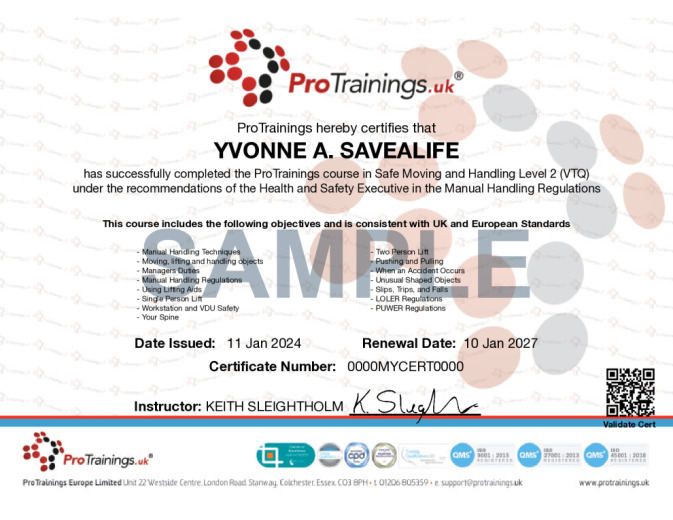SAFE MOVING AND HANDLING LEVEL 2 (VTQ)
Safe Moving and Handling is essential in every workplace to keep both yourself and others safe and healthy.
Description
This course is aimed at anyone who requires a course in manual handling and is ideal for all workplace requirements. The course is designed to meet the requirements and recommendations of the HSE Manual Handling Regulations 1992.
Correct manual handling training will reduce the risk of accidents occurring by identifying and preventing them. Manual handling is not difficult to learn but can save a lot of problems for employers and employees.
The course covers legislation, common injuries, good practice, accident prevention and different lifting aids. Also covered is a section on manual handling risk assessment and the 5 step recommended process to carry out a risk assessment.
Please note that learners undertaking a ProTrainings Trainings Course have the option to choose to take a regulated qualification.
Introductory Manual Handling Training
- Manual Handling Regulations
- LOLER Regulations
- PUWER Regulations
- Guidelines for Manual Handling
- How and Why we Lift Correctly
- Manager's Duties
Lifting Safety
- Assessing Risks
- Assessing the Individual Move
- Your Spine
- Anatomy of an Injury
- When an Accident Occurs
- Slips, Trips, and Falls
- Workstation and VDU safety
Moving and Lifting Objects
- Intro to Box Lifting
- Single Person Lift
- Two Person Lifting
- Working Together
- Moving Unusual Objects
- Odd-Shaped Objects
- Pushing and Pulling
Lifting Aids
- Using Lifting Aids
- Motorised Lifting Aids
- Conveyor Belts
- Pallet Truck
- Sack Truck
- Trolley
Learning Outcomes
1 Understand the reasons for safe manual handling
- 1.1 Outline the potential injuries and ill health associated with incorrect manual handling
- 1.2 Outline employers and employees duties relating to manual handling at work
- 1.3 Outline the consequences for non-compliance with health and safety requirements at work
2 Understand how manual handling risk assessments contribute to improving health and safety
- 2.1 Explain the terms ‘hazard’ and ‘risk’ in the context of manual handling work
- 2.2 Outline the process for carrying out a manual handling risk assessment
- 2.3 Describe the principle of the risk control hierarchy when applied to manual handling
3 Understand the principles, types of equipment and testing requirements associated with manual handling safety
- 3.1 Describe safe movement principles associated with manual handling
- 2.2 Outline the types of equipment designed to be used for manual handling tasks
- 2.3 Outline the requirements for the testing, servicing and examination of manual handling and lifting equipment
4 Be able to apply safe manual handling principles
- 4.1 Demonstrate efficient and safe manual handling principles when;
- a. applying effort to, or moving a load or object manually on their own
- b. when using manual handling aids and equipment
- c. when undertaking a manual handling task as part of a team
Certification
The content of this and all our courses has been independently certified as conforming to universally accepted Continuous Professional Development (CPD) guidelines and come with a Certified CPD Statement as well as a ProTrainings Certificate and for online courses an Evidence Based Learning statement.
